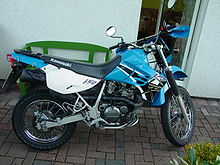Kawasaki KLR 650
The Kawasaki KLR is an enduro from the manufacturer Kawasaki Heavy Industries that was offered in Germany in 1984 and with variants until 2004 . Initially only equipped with a kick starter, an electric starter was also offered from 1985.
Model history
KL 600 A
At the beginning, the KLR 600 (KL 600 A) had 564 cm³ displacement and an output of 42 hp. It has two overhead camshafts , liquid cooling, chain-driven balance shafts, aluminum swingarm, kick starter and a road-going chassis. There were also disadvantages: The timing chain tensioner of the first years of construction was too weak, which, in combination with an ignition point of 40 ° before TDC, often led to timing chains being skipped on the kickstart models and thus in some cases serious engine damage. Only with the introduction of the KL600B, 1985 as an E-Start model, in which the ignition point was reduced to 35 ° before TDC, did this improve somewhat, but the timing chain tensioner always remained a weak point of the KLR. The sometimes considerable oil consumption (up to 1.5 liters per 1000 km) could not be prevented by the manufacturer, the cause was an under-designed cylinder liner, which quickly became oval due to a missing radiator bypass and a thermostat that opened too late.
KL 650 A
In 1987 the displacement of the KLR was increased from 564 to 651 cm 3 . The oil supply was increased from 2 liters to 2.5 liters and the rated speed was reduced by 1000 rpm. The engine developed 48 hp. The problems with oil consumption and the timing chain were only partially resolved. (see discussion) This version had a larger tank of 22 liters and a plastic cover with a small pane. This version was sold almost unchanged in the USA until 2007.
KL 650 B
In 1989 the KLR 650 was replaced by the Tengai travel enduro (KL 650 B), which was offered until 1992. The engine was taken over unchanged except for the non-available kick starter. This version had a larger tank of 23 liters and a full aerodynamic fairing with a small disc.
KL 650 C
In 1995 another KLR 650 came out (KL 650 C). Due to changed exhaust and noise emission regulations, the KLR had to get a different rear silencer and a modified carburetor set-up, so that the machine only had 42 hp. In 1996 the Kawasaki KLR 650 was taken off the market again and offered again from 1998 to 2003, the color variants changed in each model year.
The main differences to the 650A and 650B are:
- Steel rims instead of aluminum rims
- Steel swing arm
- Tank capacity of only 14 liters
- Double piston front brake caliper with 280 mm brake disc
- Fork diameter enlarged to 41 mm
- Translation of the 2nd and 3rd gear extended
KLR 650E
With the model year 2008, which appeared in late summer 2007, the KLR underwent a facelift. Compared to the A and C, the E is a little less designed for off-road use. It rather follows the Tengai for road use. From 2008 to 2018, over 100,000 units of the new E-model were sold in Australia, Canada, South Africa and the USA.
In Europe, the model is not approved due to emissions and noise regulations and is therefore not available, but there are a few own imports with exemption due to national regulations.
The changes include:
- Large panels on the 22L tank for better wind protection. Changed stern
- H7 double headlights with large fairing. The low beam can no longer be switched off
- Double piston brake at the front with 27 mm pistons and the 280 mm disc known from the Tengai and C.
- Double piston brake at the rear with 25 mm pistons and a disc enlarged from 230 mm to 240 mm
- Redesigned aluminum swing arm with improved chain tensioners
- New bench for much better long-distance use
- The stator-operated CDI has been replaced by a battery-operated TCI
- Since model year 2011, the clutch from engine number 72320 has been 'dismantled' from 8 to 7 friction disks
- Every year the colors and stickers are changed here too
- The weight has increased by approx. 15 kg compared to the previous models
In the middle of 2014 there was an intermediate model, or a preferred model 2015, called 2014.5 in KLR circles. Kawasaki has reinforced / changed the fork springs, the shock absorber and the seat and thus adapted them to today's common driver dimensions.
Technical specifications
- Model: Kawasaki KLR 650 C (KL 650 C) years 1995-2003
- Engine: DOHC 1 cylinder 4-stroke, liquid-cooled
- Displacement: 651 cm³
- Bore and stroke: 100.0 × 83.0 mm
- Compression: 9.5: 1
- Maximum output: 31 kW (42 hp) at 7000 rpm
- Max. Torque: 47 Nm at 5000 rpm
- Starting system: electric starter
- Carburetor: Keihin CVK40
- Consumption: Approx. 5.0 L / 100 km
- Ignition: CDI flywheel magneto
- Ignition time: 10 ° v. TDC at 1300 rpm
- Spark plugs: DPR8EA-9 or ND X24EPR-U9
- Lubrication system: pressure circulation lubrication (wet sump)
- Transmission type: sequential 5-speed dog gear
- Clutch: multi-disc clutch (in an oil bath), 8 friction discs, compared to 7 in the A and B models.
- Drive system: chain drive (106 links)
- Primary ratio: 2.272 (75/33)
- Secondary gear ratio: 2.800 (42/15), (43/15) on A and B models.
- Total gear ratio: 5.037 (in top gear)
- Gear ratio:
- 1st gear: 2.266 (34/15)
- 2nd gear: 1.444 (26/18)
- 3rd gear: 1.136 (25/22)
- 4th gear: 0.954 (21/22)
- 5th gear: 0.791 (19/24)
- Total length: 2.19 meters
- Total width: 0.9 meters
- Total height: 1.22 meters
- Wheelbase: 1.49 meters
- Ground clearance: 0.215 meters
- Dry weight: 168 kg
- Empty weight: 187 kg

